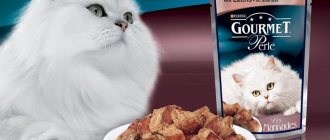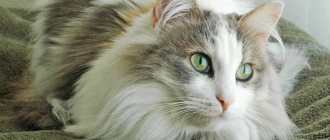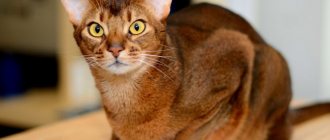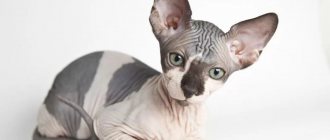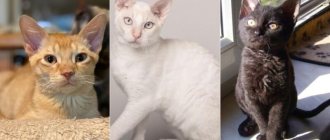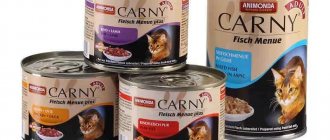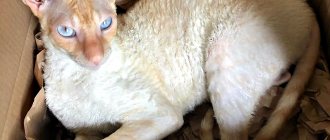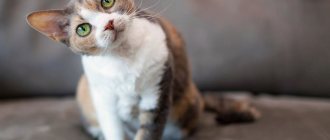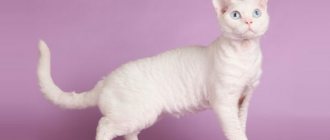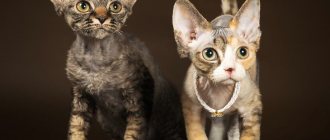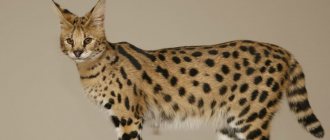Selkirk Rex
- Fact 1:
The first offspring was obtained from crossing this cat and a Persian with an excellent pedigree. - Fact 2:
As a result, in 1992, the Selkirk Rex was officially recognized and a standard was established for them - Fact 3:
Selkirks have a round head with a wide and slightly convex forehead. The muzzle is short and square. - Fact 4:
The fur coat consists of two layers - top (or guard) hair, thick and dense undercoat
An independent and overly independent cat that walks on its own - such words cannot be said about the Selkirk Rex. These pets are distinguished by a calm and balanced disposition, boundless devotion and love for their owners, good health and unusual appearance.
general characteristics
The breed was obtained by crossing the most common yard cat, Persians and British. Hence the excellent health, the need for human attention and care, plush long hair and a strong physique.
Animals are distinguished by a strong and proportional structure, well-developed muscles and bones. Therefore, they have a fairly large body mass. Weight varies from 3.5 to 6 kg. Males are usually larger and more massive than females.
The main advantage of the breed is its coat - dense, plush, wavy and very thick. Therefore, the Selkirk Rex should not be owned by people who are not willing to spend time caring for their pet. Fluffy fur requires daily thorough combing.
An interesting feature is the change in fur texture as they grow older. The kitten may be born curly. Then the wavy hairs gradually turn into straight ones. And only at the age of 8–10 months do they begin to take their final shape. The coat is fully formed only by the second year of a pet’s life.
Tendency to diseases
Cornish cats are distinguished by good health and excellent immunity. When properly cared for and properly maintained, they rarely get sick.
Due to certain physiological characteristics, animals may be susceptible to certain health problems:
- colds and even inflammation of the urinary tract (cystitis) due to hypothermia (especially important for short-haired cats);
- skin diseases;
- diseases of the gastrointestinal tract due to insatiable appetite and overeating;
- dysfunction of the thyroid gland (hypothyroidism), which is expressed in weakness, loss of appetite, weakening of the coat;
- hair loss and the formation of bald patches caused by hypotrichosis (a genetic disorder that cannot be treated, but is not dangerous to health).
Cornish Rexes rarely get sick
On average, cats of this breed live 12–13 years. But there have been cases where Cornish people lived to be 18–20 years old.
The body temperature of Cornish Rexes is slightly higher than that of other felines and is 38.5°C in adult cats and 39.5°C in small kittens.
Story
The history of the breed began in the 80s. XX century in the USA (Montana). Jeri Newman, a professional breeder, has been breeding Persian cats for a long time. After some time, the American began to think about breeding a new original breed, unlike the existing ones.
All the woman’s acquaintances and colleagues knew about this desire. As a result, Jeri received a stray cat with an unusual appearance. Her fur was so curly that it resembled a sheep's coat and the fur of a child's toy. From that moment on, work began on creating the Selkirk Rex.
The first offspring was obtained from crossing this cat and a Persian with an excellent pedigree. Three of the six kittens inherited their mother's wavy fur. To improve the breed qualities, these babies were crossed with:
- Persians - affectionate character;
- the British - ease;
- exotics - playful disposition;
- American Shorthair – square muzzle format.
As a result, in 1992, the Selkirk Rex was officially recognized and a standard was established for them. Now at TICA, appearance and temperament are assessed according to the requirements adopted on January 5, 2008. Since 2015, the Selkirk has been a closed breed. Their crossing with other (even related) breeds is prohibited.
Formation of the breed
The curly-haired kitten was born as a result of a mutation in one of the animal shelters in the city of Wyoming, located in the US state of Michigan.
The amazing baby, whose fur was not only curly, but also its whiskers, so amazed the girl employee of the shelter that she turned to a familiar breeder for advice. So young Mis de Pesto of NAFACE ended up in Jackie Newman’s nursery. Soon after the cat turned one year old, she was bred to a Persian cat. And two months later a litter appeared, in which three of the six kittens were as curly as the mother, and one of them was also long-haired. This allowed the breeder to conclude that the curly hair gene is dominant. This was surprising, because the rest of the rexes were born only as a result of a recessive mutation.
Subsequent breeding work, during which Mies de Presto was crossed with her own son, led to the birth of the second generation of wavy kittens - carriers of the dominant rex gene. One of the kittens turned out to have straight hair, but his children were also curly.
In the course of further experiments, until 2015, Selkirk Rexes were also crossed with Exotics, Americans and British Shorthairs.
Currently only intrabreeding is allowed. Officially, this species was first registered in the USA at the end of the last century, and now in many American and European international felinological organizations.
Appearance and standard
The Selkirk Rex is a well-built and proportional cat. She has perfectly developed muscles. Thanks to this, the animal appears perfectly balanced and strong. The standard imposes the following requirements for appearance:
- The build is stocky and of medium size.
- The torso is rectangular and muscular.
- The back is wide, slightly raised at the hind legs.
- The limbs are not very long and strong.
- The paws are round and large.
- The tail is thick, tapering towards the tip (medium length).
Selkirks have a round head with a wide and slightly convex forehead. The muzzle is short and square. Features: full, well-defined cheeks and curly sideburns. The eyes are round (not very large), widely spaced. The color is variable and depends on the color. The ears are small, slightly pointed at the tips. The chin is heavy. The neck is short and thick.
Wool requirements
The Selkirk Rex's calling card is its wool. Therefore, very special requirements are placed on it. According to the standard, the strongest curls should be visible on the neck and tail. “Curly” on the back of the back is variable. The density and number of curls depends on the climate in which the cat lives, the time of year and genes.
The fur coat consists of two layers - outer (or guard) hair, thick and dense undercoat. Both must curl. A distinctive feature of the breed is the chaotic arrangement of curls, consisting of three types of hair:
- straight;
- wavy;
- curly
As a result of this "erratic" growth of the coat, as well as its soft and plush texture, the Selkirks become very similar to stuffed animals come to life.
There are no specific color requirements. It can be solid or two-tone with a wide variety of color combinations - from white to blue. Intense and deep shades are considered the most preferable.
Appearance
The development of the Selkirk Rex, like some other cat breeds, went in two directions - there are cats with short hair, and there are cats with long hair. In the first version, mainly short-haired shaved and exotics “participated”, and in the second - Persians and long-haired British.
Selkirks are considered shorthaired if the hair length (in the untwisted state) does not exceed five centimeters. On all parts of the body, including the tail, the fur is approximately equal in length.
The Selkirk's eyes are unusually expressive.
Body structure, dimensions
The CFA standard describes the Selkirk Rex as a powerful, muscular animal with a harmonious build. Modern representatives of the breed have average dimensions - cats weigh up to seven kilograms, and female cats are not much inferior to them. The paws are thick and strong, and the tail is not too long and curved at the end. The head is large, round, with a wide muzzle, neat ears and nose, and huge eyes. Their color is not regulated - the main thing is that it is in harmony with the basic color tones.
Selkirk looks impressive
Features of wool
The fur coat of cats of this breed is very soft and delicate, but at the same time dense, thick and warm. On a short coat, the curl gives an interesting astrakhan effect, and on a long coat it forms beautiful curls, especially pronounced on the chest, belly and pants. Short fur is only around the eyes, which makes them especially expressive.
Selkirk wool is reminiscent of Soviet-era perm
Video: cat in sheep's clothing
Color
During the existence of the breed, taboos on some colors were lifted. Now, according to the standard, any colors and patterns in different combinations are acceptable - the American Rex has up to 250 color options, up to the wildest fantasies on the theme of color point. Even experts at exhibitions cannot always accurately classify the complex color of a particular individual - on long curls, the patterns look unclear and the colors are washed out.
Photo gallery: color palette of curly Selkirks
Blue point - delicate and aristocratic color
Short curls add charm to the most ordinary color
Not all tabby variants look expressive on long hair
A white shirtfront set in silver is the outfit of a real lord
Selkirk blue color is a typical blue British breed, but only curly White “inserts” will make any color bright
Marble patterns are very original in a curly version
Color point with tortie elements - a whimsical exclusive It is believed that the tri-colored calico curl will bring great luck Smoky colors are dynamic and mysterious
A black curly cat will always attract attention
Red astrakhan fur - there are Selkirks with this color as well. The most common bicolor is unique when framed by curls
A ginger cat of any breed is always in the top popularity
Fawn - a rare and unusual color
The lilac-cream color of the Selkirks looks mysterious and unusual.
Shades of cream - exquisite charm
Bicolor van - simple and tasteful
Not everyone will notice a tabby mackerel among the curls.
Varieties
The standard defines two varieties of the Selkirk Rex breed:
- short-haired;
- long-haired.
The only difference between them is the length of the hair. The texture requirements are exactly the same.
There is an unofficial division into two types - animals with wavy and straight hair. The latter are called Selkirk straights. Their fur is just as thick and incredibly soft, but without obvious curls or curls.
Almost all kittens are born with curly hair. But immediately after birth, determining the type of pet is not very easy. Since the smooth-haired rex can be curly at a very young age. And the future “curly” at 3–4 months will suddenly be covered with straight hairs, which will begin to curl again only by the 8th or 10th month of life. The whiskers help you find out what the fur of an adult Selkirk will look like. Straights have straight lines. Curly ones have curls.
Breeding work
Every Selkirk litter is always a surprise, even for an experienced breeder. It is impossible to predict in advance exactly what colors the kittens will be born and what their coat will be like. The fact is that in almost every litter there are both curly and straight-haired babies, but no one can guarantee that curly hair will not straighten, and straight hair will not curl. The only thing you can be sure of is: if both parents had long hair, then the babies will inherit their long hair.
The main difficulty of breeding work is the selection of parent pairs
Producers must have pedigrees and veterinary passports, be absolutely healthy at the time of mating and treated for all types of parasites. The first mating of a cat can take place no earlier than the third heat, and childbirth - no more than three times in two years. If you do not plan to breed, have your pet spayed. The optimal age for such an operation is from eleven months to one and a half years.
Video: Selkirk Rex in your home
Temperament
The advantage of the breed is sociability and affection for people. Cats sense the mood of their owners very subtly. Always ready to play and frolic. They know how to “comfort” if they feel that the owner is in a bad mood or state of health.
These cats don't like to be left alone. Without attention and care, they begin to feel very sad. They need the love and attention of all family members like air. Selkirks love to sit on laps, willingly climb into your arms and allow themselves to be stroked.
Fluffy pets get along well not only with people, but also with pets. Selkirk will not fight for primacy in the house or win the position of leader among four-legged family members. Aggression, cowardice, and mistrust are not typical of this breed.
Selkirks feel free and at ease not only with their family, but also with strangers. They have a reserved and flexible character. He behaves absolutely calmly in a new environment. Very important qualities if you plan to participate in exhibitions or competitions.
If you add intelligence and an affectionate disposition to the above character traits, the Selkirks become simply ideal pets. It is no coincidence that more and more breeders call this breed the most delightful among all representatives of the cat world.
Description of the Cornish Rex breed
Cornish Rexes look like true English aristocrats. They are graceful, elegant and graceful. They can be classified as the same type as greyhounds. The appearance of these cats is just as colorful and aristocratic.
Cornish cats look like real English aristocrats
External data
The Cornish have a long, muscular, dry and lean body with a characteristic curved back. The shoulder girdle, hips and chest are proportional, the general physique is reminiscent of Egyptian cats.
There are three varieties of this breed: English, European and American types. They all have some nuances in the exterior.
The WCF (World Cat Federation) standard describes the main characteristics of the breed as follows:
- the head is small, wedge-shaped, about 30% longer than wide;
- cheekbones are well defined and high;
- a well-developed, strong chin forms an almost vertical line with the tip of the nose;
- the nose is long, thin, straight, slightly widening towards the nostrils;
- eyes are large or medium-sized, almond-shaped, slightly slanted (the upper corners are slightly higher), color from yellow to green depending on the color of the coat (individuals colored according to the Siamese type have blue eyes);
- the ears are large (sometimes huge), wide at the base, slightly rounded at the tips, set high and wide apart;
- the mustache (vibrissae) and eyelashes are long and curled (indentations on the skull are noticeable in the area of the mustache);
- the tail is long, whip-shaped, extremely flexible;
- the limbs are strong and long, the hind limbs are significantly longer and more powerful than the front ones (which allows them to jump perfectly);
- height at the withers - 23–27 cm;
- male weight is 4–5 kg, female — 3–3.5 kg.
Cornish Rexes have a muscular and lean body, the hind legs are more powerful than the front ones.
The coat is wavy, thick and short, guard hairs are completely absent . The fur is very soft and silky to the touch. Curls can have a different character: from a large, slightly open wave to a small and very tight curl (like a washboard). Astrakhan fur is finally formed only after 7–8 months.
The muzzle is also covered with very short and fine hair.
The Cornish Rex's coat is short, soft and delicate, the coat is curled in uniform waves throughout the body.
Absolutely any colors of Cornish Rex cats are allowed. There are individuals with monochromatic and variegated two-color colors and even tricolor.
Tortoiseshell corniches are often sterile (cannot bear offspring).
Cornish Rexes even come in a rare tortoiseshell color.
The most common colors:
- white;
- black (the color is very dense and saturated, mixing of shades or haze is not allowed);
- blue (even throughout the body);
- red (brick brown);
- calico (various variegated spots are located on the main white background).
The standard allows for a variety of colors; tri-colored cats look very interesting
Exhibition requirements for animals are very strict. Bald spots and bald patches on the body, as well as insufficient coat thickness, are not allowed. The presence of even a small amount of guard hair is considered a defect. Individuals with a deformed tail (kinks) and an excess or insufficient number of toes are rejected. Special requirements are imposed on miniature size; the weight of pets should in no case exceed the norm. A serious drawback is the overweight massive body with wide bones. The iris of the eyes should be painted evenly.
Eyes can be different colors. The main thing is that they are painted evenly
From personal experience. We saw the Cornish Rex for the first time at a cat show. The children were still small then. And for them these animals were a wonder. It’s surprising that the owners allowed them to pet their pets. True, you first had to wipe your hands with a damp bactericidal wipe. The wool is completely unusual; it doesn’t even feel like wool at all, but the most delicate silk. Little kittens are especially cute. They are both awkward and graceful at the same time.
Character
Cornish Rex can be safely called highly intelligent animals with a fine mental organization, they are so smart and perspicacious. They don’t need to explain the truisms, because a creature with blue blood (aristocrat) will never climb onto the dining table, will not go to the toilet anywhere and will not hang on the curtains. Even when they become adults and reach reproductive age, cats never mark their territory. Rancor and mischief are not at all in their nature.
Cornish cats are credited with certain healing qualities. It is believed that their company has a positive effect on the human nervous system and can cure depression.
Cornishes are unusually curious, emotional and sensitive, they definitely need to be aware of everything that happens in the house. These subtle and gentle natures may well be offended if the door is closed in front of them. There is no need to shout at these animals, much less physically punish them. Cats of this breed are highly talkative; they will always have something to say on any occasion, but will never yell in a bad voice. Each individual has its own set of sounds applicable to a specific situation.
Cornish people love to talk, they always have something to say, but when they are silent, you get the feeling that they know and understand everything
Pets become strongly attached to their owners, but choose only one person to play the role of leader, whom they will follow on their heels. They are highly trainable and capable of performing a number of simple commands and tricks, much like a dog. They enthusiastically carry balls and other small objects thrown at them.
Rejoicing at the arrival of his owner, the Cornish wags his movable tail like a dog.
Cornish Rexes have an extremely playful, restless and lively temperament. A calmly lying cat can be seen extremely rarely; usually he is always businesslike and busy with his endless games. Your pet will need to purchase a large number of different toys, otherwise he will choose items that are not quite suitable for this. Energy and playfulness almost do not fade over time; even quite old cats love to frolic and chase the ball. But they definitely need company; left alone, pets get very bored. Therefore, you should not get such a sociable cat if you do not have the opportunity to give him sufficient attention.
Cats of this breed are unusually friendly and completely devoid of aggression; they regard strangers as new playmates. They manage to live in peace with all family members and other pets. They are distinguished by an affectionate and flexible disposition; they can fuss with small children ad infinitum and allow them to do whatever they want with them. Tired, they will prefer to rest on the owner’s lap, then, after a short respite, they will again rush to exploits. The animals are curious to the point of fearlessness; even a dog’s barking does not scare them. Thanks to the presence of intelligence, they can penetrate into any forbidden, but terribly desired place. They love to walk outside, but should only be taken out on a leash.
The Cornish can play indefinitely
With a lack of attention and affection, the Cornish can get sick.
From personal experience. Cornish Rexes love to climb to the very top and view all the surroundings from there. The neighbor's cat loved to climb onto the boxes on the balcony. She was not even bothered by the fact that boxes periodically fell with her and made quite a lot of noise.
Health
Selkirk Rex is a young breed, not burdened with the burden of hereditary diseases. A thick fur coat reliably protects from cold and drafts, so cats are not afraid of even harsh climatic conditions. They usually live a long life - about 17 years.
One of the few “vices” of Selkirks is a tendency to overeat. They simply love to eat delicious food and a lot. No matter how much food is poured into their bowl, they eat it all, without leaving a crumb. Therefore, owners should be very careful and avoid gluttony. After all, excess weight can cause the development of many ailments.
In theory, due to Persian and British genes, Selkirks may be prone to heart or kidney disease. But breeders are trying to reduce the risk of developing these diseases by allowing animals with ideal characteristics to be crossed.
Maintenance and care
If it were not for the thick coat, which is prone to tangles, one could say that caring for the Selkirk is not at all difficult. However, the need for daily combing of the coat and heavy shedding twice a year can cause some inconvenience to the owner.
In general, care comes down to following the usual procedures for all pets:
- weekly inspection and cleaning of ears;
- trimming nails as needed;
- examination and cleaning of teeth (on your own or in a veterinary clinic);
- undergoing a mandatory course of vaccinations and treatment against parasites;
- Thorough cleaning of the tray and sleeping area.
Cats need to wash their eyes periodically. If the Selkirk is light in color, you should not use chamomile decoction or tea infusion for this purpose. Products can leave unsightly stains on your pet’s light-colored face.
Since Selkirks are prone to overeating, they need to be given good exercise. Your pet furry will not mind active games. After all, contact with a person and any joint activity gives him pleasure.
Features of hair care
The tendency to shed heavily and thick fur is a reason to avoid buying a Selkirk for people suffering from allergies. For a long time there was an opinion that this breed was hypoallergenic, but it turned out that this was not the case.
Those who cannot devote time to caring for their pet’s luxurious fur should not buy a Rex. Selkirks need to be brushed every day. And during molting several times a day. To do this, you will have to acquire a whole arsenal of special tools:
- furminator for removing dead hair;
- a fine-toothed brush for the undercoat;
- a long-tooth comb;
- suede napkins that remove dust, small debris and fallen hairs;
- scissors to remove tangles.
The latter can easily appear on a fur coat if it is not combed. It is almost impossible to untangle them, and cutting them off is also undesirable. Then the pet will lose all its charm. If a hairball begins to form on the body, it is carefully cut vertically. Then carefully sort out the tangled strands with your hands.
In order for the Selkirk's coat to always be beautiful, he will have to be bathed often - 1 or 2 times a month. Water procedures have a beneficial effect not only on the condition of the hair, but also on the skin. You need to wash your cat with a special shampoo for animals, not forgetting to thoroughly rinse off any remaining product. After water treatments, the pet will have to be thoroughly dried. However, experts strongly do not recommend using a hair dryer for this purpose.
Diet of an adult Selkirk Rex
The diet differs little from the diet of other purebred cats. The owner can choose one of two possible options - ready-made food or natural products.
In the first case, you should not save money and buy premium dry mixes. In this case, the pet will receive the necessary amount of vitamins and nutrients. Additional feeding with mineral complexes is not required. Economy segment feed is not recommended for several reasons:
- contain many food additives and flavorings;
- Often the composition contains cereals or corn flour, which causes allergies.
When feeding natural food, the Selkirk owner will have to take care of creating a balanced diet himself. The daily menu should include:
- dietary meat (chicken, turkey, rabbit, beef) - before feeding, the meat must be doused with boiling water;
- offal – cartilage, heart, kidneys;
- fermented milk products (cottage cheese, kefir, fermented baked milk, unsweetened yogurt) saturate the body with potassium;
- vegetables, fruits and herbs are sources of vitamins and minerals, and also wonderful treats.
When feeding natural products, vitamin and mineral complexes will have to be added to the food. Before purchasing medications, it is better to consult a veterinarian. After all, an excess of nutrients, as well as a lack of them, do not lead to anything good.
Catering
If you want only the best for your pet, you cannot help but pay special attention to what and in what quantities he eats. Whatever you choose - ready-made food or a natural menu - choose fresh, high-quality products that do not contain artificial preservatives, dyes, GMOs and other harmful components.
Natural products
If you choose a natural menu, remember: you cannot feed your cat only meat. The diet should contain:
- Porridge (rice, oatmeal, buckwheat, semolina).
- Boiled vegetables (zucchini, pumpkin, carrots, asparagus, green beans).
- Vegetable oils (olive, flaxseed, sunflower).
- Fermented milk products (yogurt, sour cream, fermented baked milk, cottage cheese).
- Eggs.
You cannot give salty and sweet foods, smoked meats, seasonings, alcohol, bones (even boiled ones).
Recommended food
Industrial ready-made food is a real salvation for those who don’t have time or don’t like to cook. But don’t take just any food from the store shelf, and the price that’s too low should alert you. Get used to reading the labels on packages.
- Economy feed: Gemon, PROtail, TerraCat.
- Premium food: Club 4 Paws, Native food.
- Super premium: Guabi Natural, Landor, Leonardo, Monge.
- Holistic food: Now Fresh, One&Only, Orijen, Power of Nature, Pure Luxe.
Super-premium and holistic foods are considered the best in the general food rating. In their production, natural preservatives and antioxidants, less allergenic sources of carbohydrates (rice, oats, barley), meat and fish, dried vegetables, berries, and vitamin and mineral supplements are used.
Below are the recommended foods. Links with the names of the food are clickable, on them you can, within our website, get acquainted with the descriptions of the food and read reviews from owners of Selkirk Rex cats.
| Holistic | Super premium | Premium |
| Nutram | Karmy | Safari |
What to feed a kitten
The diet of kittens is always different from the feeding pattern of adult pets. First, food should be given more often. Not 1-2 times a day, but at least 4 or 5. The older the baby gets, the fewer meals he needs.
You should definitely ask the breeder what the animal’s diet was like before purchase. Its sudden change can lead to stomach upsets or more serious problems. If the owner independently weans the baby from breastfeeding, then mother’s milk should not be replaced with cow’s milk. Most cats digest it very poorly. It is better to introduce fermented milk products into your diet:
- cottage cheese;
- curdled milk;
- kefir;
- low-fat sour cream;
- Ryazhenka.
Children will be gradually accustomed to the new adult diet. It is useful for kittens to add vitamin B to their food during the period of fur formation.
Despite the relative youth of the breed, the Selkirk Rex has already gained great popularity. Kittens are relatively inexpensive. For just 10–20 thousand rubles you can buy a cat with an ideal character, plush fur and original appearance.
